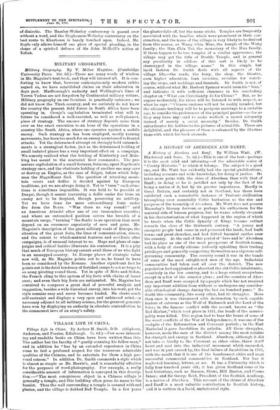A HISTORY OF ABERDEEN AND BANFF.
A History of Aberdeen and Banff. By William Watt. (W. Blackwood and Sons. 7s. 6d.)—This is one of the best—perhaps it is the most solid and informing—of the admirable series of "County Histories" to which it belongs. The subject is a good one, and Mr. Watt has evidently had the special qualifications, including accurate and wide knowledge, for doing it justice. He takes more pains with the shire of Aberdeen than with that of Banff; in doing £0 he is justified not only by the fact of his being a native of it, but by its greater importance. Hardly in Great Britain, and certainly not in Scotland, has there been exhibited such a remarkable instance of Teutonic civilisation triumphing over essentially Celtic barbarism as the rise and progress of the township of Aberdeen. Mr. Watt does not possess Macaulay's literary fervour, or perhaps his enthusiasm for the material side of human progress, but he waxes soberly eloquent in his characterisation of what happened in the region of which he treats when the Celtic dynasty of Kings became extinct towards the close of the thirteenth century. "A young and energetic people had come in and possessed the lands, had built towns and great churches, and had dotted baronial castles over the country. At the end of this period of ' luve and le' Aberdeen had its place as one of the most prosperous of Scottish towns, with a body of sturdy citizens jealously upholding their trading privileges and generally comporting themselves as a vigorous self- governing community. The country round it was in the hands of some of the most enlightened men of the age. Industrial communities had taken root all over the district. The new population had supplanted or absorbed the old Celtic inhabitants, —entirely in the low country, and to a large extent everywhere except in a few of the remoter glens ; and the counties of Aber• deen and Banff were occupied by a people which has not received any important addition from without or undergone any consider- able ethnological change during the last six hundred years." No doubt this community, like every other, had its struggles. More than once it was threatened with destruction by such capable leaders of caterans as the Wolf of Badenoch and the Lord of the Isles ; in the famous conflict with the second, known as "the Red Harlem," which took place in 1411, the heads of the munici- pality were killed. This region had to bear the brunt of some of the worst conflicts of the War of Independence; it was one of the cockpits of the Reformation and Covenant periods ; in the Earl Marischal it gave Jacobitism its paladin. All these struggles, however, made the men of the district among the most notable for strength and energy in Scotland. Aberdeen, although it did not take so kindly to the Covenant as other cities, threw itself heart and soul into tho industrial movement which succeeded, and was in part caused by, the final failure of Jacobitism in 1745, with the result that it is one of the handsomest cities and most successful commercial communities in Scotland. Nor has it neglected learning, letters, or art. It has a University which is fully four hundred years old ; it has given Scotland some of its best historians, such as Masson, Skene, Hill Burton, and Cosmo Innes ; and Sir George Reid, President of the Scottish Academy, is a native of Aberdeen. This account of the shires of Aberdeeo and Banff is a most valuable contribution to Scottish history, and it is written in a lucid, unrhetorical style.


















































 Previous page
Previous page